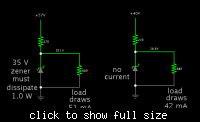- Joined
- Apr 1, 2011
- Messages
- 15,187
- Helped
- 2,900
- Reputation
- 5,812
- Reaction score
- 2,982
- Trophy points
- 1,393
- Location
- Minneapolis, Minnesota, USA
- Activity points
- 113,784
Re: Buck circuit questions.
The customary arrangement for zener regulation is below. In parallel with the load. Resistor low enough to carry enough mA to the IC.
Supply level on the IC will still vary. The series resistor must be rated for more than 1 watt. These are safeguards to get proper operation, for all PoE supply volt levels. It depends on what range of supply the IC likes.

Your zener diode is in series with the IC supply pin. The IC gets power through a 12k resistor (R1). The most it will get is 4 mA. There's only a remote chance that's enough.
This must apply to the internal transistor. I do not believe the IC is able to govern an external transistor.
I've seen datasheets which show one example with an external mosfet/transistor, and another without. It's possible you can get either to work with your IC.
If you can use an external switching mosfet, the 100 mA restriction probably won't apply.
A free simulator called LTspice is frequently recommended by posters here. It may contain switching controller IC's which you can try.
I spent some time this morning pondering how to power this IC (as opposed to looking for another one) when suddenly I remembered reading somewhere that you can build a voltage divider instead of using the 19-26kohm PoE sensing resistor. I've attached my new schematic to show how I thought that would work. I also renumbered the components.
The customary arrangement for zener regulation is below. In parallel with the load. Resistor low enough to carry enough mA to the IC.
Supply level on the IC will still vary. The series resistor must be rated for more than 1 watt. These are safeguards to get proper operation, for all PoE supply volt levels. It depends on what range of supply the IC likes.

Your zener diode is in series with the IC supply pin. The IC gets power through a 12k resistor (R1). The most it will get is 4 mA. There's only a remote chance that's enough.
One part I am worried about with this configuration is that the controller's transistors max current rating is only 100mA. But later in the datasheet it says "Each transistor has antisaturation circuitry that limits the current through that transistor to a maximum of 100 mA for fast response." So, I'm not sure if I'm allowed to exceed that or not. I used the voltage divider calculator at hyperphysics to determine the power available at the IC and divided by the voltage to get the current which seems to be at acceptable levels.
This must apply to the internal transistor. I do not believe the IC is able to govern an external transistor.
I've seen datasheets which show one example with an external mosfet/transistor, and another without. It's possible you can get either to work with your IC.
If you can use an external switching mosfet, the 100 mA restriction probably won't apply.
A free simulator called LTspice is frequently recommended by posters here. It may contain switching controller IC's which you can try.